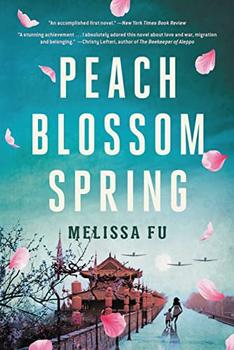Summary | Excerpt | Reading Guide | Reviews | Beyond the Book | Read-Alikes | Genres & Themes | Author Bio

A Novel
by Melissa FuThis article relates to Peach Blossom Spring
The family at the center of Peach Blossom Spring carries a handscroll with them as they flee their home in the Hunan Province of China during the Second Sino-Japanese War. The scroll illustrates a fable, the significance of which grows and changes for main character Renshu over the course of his life. The handscroll has been a form of art and narrative storytelling in China since the Spring and Autumn period (770-481 BCE). They were initially made with bamboo or wood, but during and after the Eastern Han period (25-220 CE), silk and paper became the predominant materials used. Earlier handscrolls feature ink drawings and writing, but during the Tang Dynasty (618-907 CE), watercolors became the primary medium. Over the years, Chinese handscrolls went from being used primarily for documentation, i.e., a medium for writing down and sharing religious texts, to an art form with aesthetic, cultural and ceremonial significance.

The type of handscroll described in Peach Blossom Spring is a horizontal scroll mounted on a wooden roller that is gradually unrolled to reveal a narrative, similar to turning pages in a book. These handscrolls can be up to several feet in length, depending on the narrative being conveyed, and are unrolled from right to left. When rolled up, they are often bound with a silk cord with a jade or ivory fastener. The narrative depicted may be entirely pictorial, or may include painting and written words, carefully inscribed with calligraphy.
The Metropolitan Museum of Art offers insight into the experience of looking at a handscroll: "[S]eeing a scroll for the first time is like a revelation. As one unrolls the scroll, one has no idea what is coming next: each section presents a new surprise." Unlike a painting hanging on a wall, handscrolls like these are generally not kept on display, but stored in their rolled up state. Each time it is unrolled and viewed is like a new experience, quite different from looking at a painting that is always on view and might blend into the furniture of a room as one becomes accustomed to seeing it. (This also differentiates the handscroll from the hanging scroll, which is vertical rather than horizontal and designed to be hung on a wall.) In some cases, handscrolls contain colophons — notes left by the artist and/or viewers, usually expressing their thoughts and opinions upon encountering the images and narrative on the scroll. During the Ming Dynasty era (1368-1644 CE), artists would gather in salons to create and share handscrolls collaboratively, adding colophons to one another's work.
Handscrolls have been prevalent throughout East Asia, but are most associated with China and Japan. The art form arrived in Japan along with Buddhism in the eighth century. In the video below, Melissa Fu discusses the significance of the handscroll in her novel while showing an example of a hanging scroll.
"Twin Pines" handscroll by Zhao Mengfu circa 1310, courtesy of The Metropolitan Museum of Art
Filed under Music and the Arts
![]() This "beyond the book article" relates to Peach Blossom Spring. It originally ran in April 2022 and has been updated for the
February 2023 paperback edition.
Go to magazine.
This "beyond the book article" relates to Peach Blossom Spring. It originally ran in April 2022 and has been updated for the
February 2023 paperback edition.
Go to magazine.
Your guide toexceptional books
BookBrowse seeks out and recommends the best in contemporary fiction and nonfiction—books that not only engage and entertain but also deepen our understanding of ourselves and the world around us.